deltawaveCoG
Manual
3systec Controls Mess- und Regeltechnik GmbH 27.06.2023 V1.5
9Measuring windows deltawaveCoG.................................................................32
9.1 Headline ..............................................................................................32
9.2 Measuring window „Flow 1“ .................................................................33
9.3 Measuring window "Flow 2“ .................................................................34
9.4 Password protection............................................................................35
10 The main menu (complete menu).............................................................36
10.1 Loading, saving and managing parameter data...................................36
10.2 The pipe parameters............................................................................38
10.3 The Fluid Setup ...................................................................................39
10.4 The Transducer Setup.........................................................................41
10.5 Parameterization of the inputs and outputs .........................................41
10.5.1 Parameterization of the 4-20mA outputs.........................................41
10.5.2 Parameterization of the relay..........................................................43
10.5.3 Parameterization of the pulse output ..............................................44
10.5.4 Pulse-Overflow-Error; IOE ..............................................................45
10.6 Data Transfer & Logger.......................................................................45
10.6.1 Modbus...........................................................................................45
10.6.2 The Data Logger.............................................................................46
10.6.2.1 Activation of the data logger..................................................47
10.6.2.2 Administration and structure of log data................................47
10.6.2.3 Starting a time-controlled data record....................................48
10.6.2.4 Cancelling a time-controlled data record...............................49
10.6.2.5 Quick-Logger.........................................................................50
10.7 System Settings...................................................................................51
10.7.1 Editing the time and date ................................................................51
10.7.2 Changing the indicator light.............................................................51
10.7.3 Changing the menu language.........................................................52
10.7.4 System test.....................................................................................52
10.7.5 System Reset..................................................................................54
10.7.6 Reference conditions......................................................................54
10.7.7 Calculation test ...............................................................................55
10.8 Unit selection.......................................................................................55
10.9 Calibration ...........................................................................................56
10.9.1 Flow-Offset......................................................................................56
10.9.2 PT100 Calibration...........................................................................56
10.9.3 Calibration of analogue outputs ......................................................57
10.9.4 Calibration of analogue inputs.........................................................57
10.10 Miscellaneous Parameters ..................................................................58
10.10.1 Cutoff und Burnout..........................................................................58
10.10.2 Damping..........................................................................................59
10.10.3 Zero ................................................................................................59
10.10.4 The totalizer (counters)...................................................................60
10.10.5 Pipe roughness...............................................................................61
10.10.6 Sensor test......................................................................................61
11 Additional information about the hardware...............................................63
11.1 Hardware and Software Reset.............................................................63































